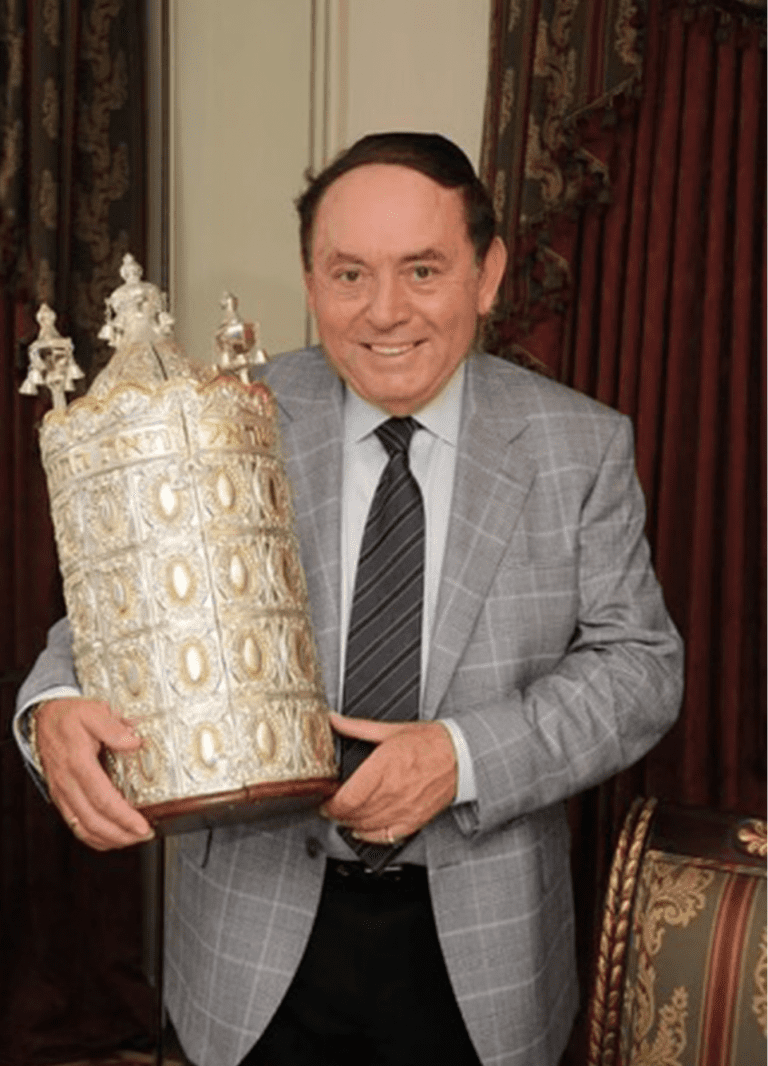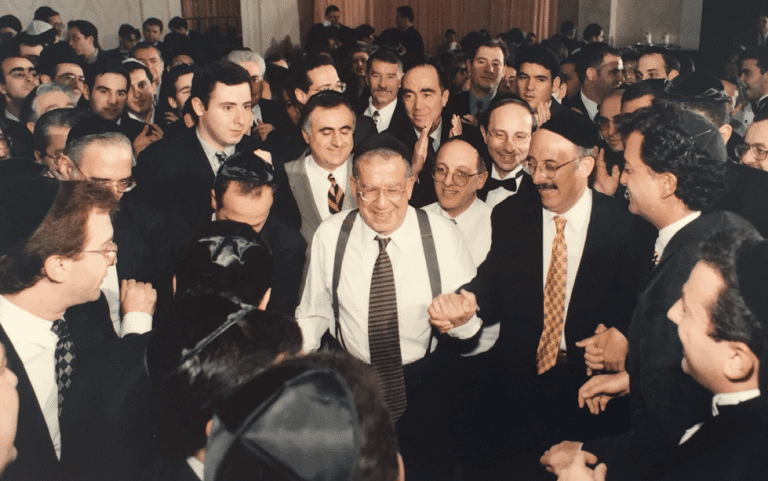On April 22nd, Mr. Charlie Saka, Yeshaya Ben Laura, a”h, passed away at the age of 80, surrounded by his loving family. He is survived by Brenda, his wife of 57 years, and his children Sammy, Raymond, Jeffrey, Laurie (Mizrachi), Sally (Cohen), their spouses, grandchildren, and great grandchildren.
Many rabbis, friends, and family members spoke at Charlie’s levaya and arayat. I apologize if I did not acknowledge all who contributed to this article or if I misunderstood any of the remarks.
Remembering a Man of Hesed Who Loved His Fellow Jews
Charlie Saka lived his life to the fullest, devoting himself completely and lovingly to Hashem, to the community, to doing hesed, and to his family.
It is difficult to adequately pay tribute to a man who was called “a giant” and who left us with a tremendous legacy. He was a man who left abundant gifts and a remarkable mark on the community.
Sammy, his oldest son said, “My father, of blessed memory, dedicated his entire life to helping others. No cause was ever too small, and no voice overlooked. Everyone who knew him loved him. He had a special way of connecting with every person that he encountered. My father will be greatly missed for his genuine leadership and will forever remain a shining example to all.”
Charlie Saka was of Syrian descent. He was a student of his community and had amazing knowledge about its history and he loved to share it.
Remembering a Man of Action
He was warm, friendly, and outgoing. He was a man of action, a fundraising master, a blessing to his family, community, and to klal Yisrael. He was a man who had his hand in everything that was hesed and community related.
With his loving life partner Brenda by his side, he lived and breathed the mitzvah of, “You shall love your neighbor as yourself.” He believed that all Jews are responsible for each other.
Mr. Saka’s dedication to hesed and the community has already impacted generations. He and Brenda inspired their children, leading by example. Their sons and daughters and families are following in their footsteps. Devoting themselves on the path of Torah, mitzvot, and community service. They are all active leaders of various community institutions, including Congregation Magen David of West Deal, Hillel Yeshiva, Sephardic Bikur Holim, and DSN Community Center. They saw their father doing hesed every day and refer to him as their hero.
Charlie Saka was a humanitarian and a philanthropist. He worked to establish the Magen David Synagogue complex near his home in West Deal, New Jersey, which includes buildings for both religious and social occasions. He was the Chairman of the Board of the synagogue at the time of his passing. He worked to sustain and expand Hillel Yeshiva, and was instrumental in the building of the DSN Community Center in the heart of the Jersey Shore. He continually gave both his time and financial support and helped thousands of people across the world.
Professionally, Charlie Saka was a self-made man and is recognized as the visionary leader who built Sakar International into a global consumer electronics and accessories company.
The Levaya – Honoring Charlie Saka
Charlie Saka passed away on the seventh day of Pesach, the time of Kiryat Yam Suf, the night of many miracles. In the months preceding his death, there was a community outpouring of love, support, concern, prayers, and learning for him. His funeral took place the day after Pesach ended, Isru Chag. Rabbi Saul Kassin of Congregation Magen David explained that there are no eulogies of crying during the month of Nissan, and would therefore be postponed to Shloshim. Instead, those in attendance would learn about the great life of a giant of the community, not in the form of a eulogy.
Rabbi Kassin shared a pasuk from Tehillim. “The days of our lives are 70 but by reason of strength they may be 80. “Charlie Saka lived those exact 80 years. When I think of Charlie, I think of inner strength.”
Once Charlie Saka set out to do something, he saw things to the end, despite any stumbling blocks. His strength allowed him to accomplish all he did.
Charlie Saka’s was a dedicated and loving husband, father, grandfather, and great-grandfather. He expressed pride and gratitude for how his wife, children, and their spouses were there for him in his time of need.
After his family, there was nothing he loved more than the synagogue. He worked tirelessly for 43 years for his shul. He lived the pasuk, “Make Me a sanctuary and I will dwell within.”
Charlie talked about the shul wherever he went and made sure that the shul and Torah Center were beautifully equipped. He demonstrated that the shul was the community’s home, and everything was chosen with the utmost care and dedication to Hashem.
This Is My Gd, and I Will Glorify Him. (Shemot 15:2)
Charlie beautified the sanctuary in a dignified manner. His son-in-law Eddie Cohen said that his father-in-law lived by example, l’shem Shamayim. He possessed vision, and helped the community flourish. With Hashem’s help, “The shul is the house that Charlie Saka built.” There was no job too big or small for him – from fundraising millions of dollars for the building projects, to printing each plaque, to even picking up garbage on his way to shul. He was truly hands-on, in every aspect of the shul . Before he passed away, he asked Rabbi Kassin to continue to make the shul a shining star. According to his close friend, Maurice Zalta, Charlie’s blood ran through the pipes of the shul. When Maurice moved to West Deal, Charlie befriended him and got him involved with the shul and its expansion.
Rabbi Yosef Galimidi of the Edmond J. Safra Synagogue in Aventura, spoke of Charlie’s many middot and tremendous leadership qualities. He loved peace, Torah, and his community. Charlie passed away, but his spirit, legacy, and lessons survive. He built the training ground and inspired his children to be leaders.
One of Charlie Saka’s greatest projects was the English translation of the Yalkut Yosef, a halachic work written by Rabbi Yitzhak Yosef, based on the rulings of Rabbi Yosef’s father, the former Rishon LeTzion, Hacham Ovadia Yosef, zt”l. Charlie’s son Raymond joined in this endeavor. The entire family traveled to Israel in 2007 and celebrated the dedication of the books.
Raymond said, “Dad passed these lessons on to us by living them every day. During daily commutes together back and forth to work in Edison, we watched and learned how he got things done for the community. Phone call after phone call, he wouldn’t quit until he got the results he wanted. From this we learned that quitting is never an option. When we start a job, we finish it.
Charlie’s Roots
Charlie’s friends described him as a regular guy from Bensonhurst, Brooklyn. He went to Magen David Yeshiva and always had a stickball in his hand. At 12 he was delivering groceries on his bicycle and doing whatever he could to earn money. Hard work was instilled in him from a very young age. Charlie went into business with his father and opened their first electronics store. He considered his life complete when he met and married Brenda in 1965 and started their family.
Given that Charlie was buried right after Pesach, Rabbi Shlomo Diamond talked about Bnei Yisrael having a slave mentality. They were afraid to leave Egypt, yet they had the potential to grow. He equated Charlie’s growth to that of the Israelites. Charlie grew from being a regular guy from Brooklyn into a great leader, building a wonderful family and community, and doing hesed every day. His hallmark was his determination and persistence.
Charlie’s birth was a miracle. His mother was told she could not have children. And then Hashem sent Charlie! He overcame childhood adversities. Tragically, his mother died when he was a young boy. At eight, Charlie was struck by a car and was in a coma for a week. When he came out of it, he did not dwell on the adversity he suffered. He went on to achieve great things, despite setbacks.
Acts of Loving Kindness
“Acts of kindness are greater than charity since they can be done for both the rich and poor… Charity can only be done with one’s money, while acts of loving kindness can be performed both personally and with one’s money.”– Rambam (Hilchos Aivel 14:1)
Charlie exemplified a man who did acts of loving kindness. His son Jeffrey said, “My dad reminds me of Avraham Avinu, who overcame many challenges and tests in his life. Avraham exemplified hachnasat orchim. People gravitated towards him, he was a man of action, ran to do mitzvot, and was the forefather of our nation. We know that Hashem loved Avraham. There’s a pasuk in Parashat Vayera that says, ‘For I have loved him because he commands his children and household after him that they keep the way of Hashem through charity and justice.’ As I review my dad’s life story and the values he instilled in us, it is very clear that everything we are is because of our parents. All of their hard work and determination on behalf of the community is always le’Shem Shamiyim. We have been so fortunate to have been raised in that environment, wanting to always give back, and it has had a dramatic impact on each of us.”
Charlie Saka was a humble, honest, caring, and generous man. He had an infectious smile and was a great role model for all of us. He was not pretentious, and he asked for advice of others.
If someone was in the hospital, Charlie did his best to pay a visit. He regularly paid shiva calls, always speaking about the person who passed away and comforting their families with stories about their loved one.
Private Acts of Hesed
Charlie loaned people money privately. He helped people starting out in business with credit and merchandise. The shul was able to expand without worry. Charlie personally guaranteed each project with his own money until all the money was raised.
Charlie often helped families to pay for weddings. He believed people should live with dignity, and as such, he gave tzedaka behind the scenes and helped financially challenged individuals find employment.
Respect for Rabbis and Chachamim
Charlie had tremendous derech eretz towards his rabbis. His daughter Sally Cohen recalled the deliberations Charlie made when choosing a comfortable chair at Staples for the rabbis’ offices. This past summer, her parents embarked on their latest project, building new offices for the rabbis of our shul.
Sally told of her father inviting hachamim and dignitaries to the home as if it was a normal occurrence. He always said, “We are standing on the shoulders of the giants that came before us.” He instilled in his family a love of their Sephardic heritage and he taught the community how to be givers.
A Builder Who Served Hashem
Rabbi Edmond Nahum of the Deal Shul spoke about the zechut Charlie had to help build beautiful shuls and yeshivot. He compared Charlie to Avraham who created an angel, a malach with every zechut he performed.
Rabbi Eli Mansour likened Charlie Saka to the biblical cedar trees. “He was a towering figure, unstoppable, and kept on going. He was a tzaddik – motivated, propelled to do good l’Shem Shamayim, and serve Hashem with no secret agenda.”
Charlie and Brenda helped to build the Sephardic Social Center on the shul grounds. Over 200 seniors come daily to relax, have lunch, and play cards. They make sure everyone is comfortable and happy every day.
Charlie’s Daughter Laurie Remembers
Charlie’s son-in-law Marc Mizrachi said people could not say no to Charlie, and he left a lasting impression wherever he went, helping people in so many ways. Marc shared some of his wife Laurie’s thoughts. Laurie was the first daughter after three sons, and she said that her father always made her feel so special. He valued religion above all else, carrying a sefer Torah and organizing minyanim wherever we traveled. “My father made the impossible possible. He taught that we need to be an example for our community and for others. From when we were all very young, our parents encouraged our community activities and supported us in so many ways, with whatever we chose to get involved with. My father inspired each of us to go after what we felt passionate about and provided us with encouragement and motivation to accomplish our goals.”
Rabbi Kassin’s Parting Words
Charlie was generous and enjoyed giving. He also took pleasure in making sure people were comfortable. When Rabbi Kassin moved to the community, Charlie made sure he and his family had everything they needed.
Rabbi Kassin offered these heartfelt words, “Dear Charlie, leich b’shalom, go in peace. Thank you for being my partner, we made a great team, and we did things l’Shem Shamayim. With Hashem’s help, I will continue our work with your children and grandchildren.”
“You and Brenda were a dynamic duo. We must learn how to treat our spouses from you and Brenda. Brenda, you were his ezer kinegdo, his strength, his confidante, his everything.”
Those interested in sharing their thoughts, memories, and condolences are encouraged to email CharlieSakaLegacy@gmail.com.
Ellen Geller Kamaras, CPA/MBA, is an International Coach Federation (ICF) Associate Certified Coach. Her coaching specialties include life, career, and dating coaching. Ellen is active in her community and is currently the Vice-President of Congregation Bnai Avraham in Brooklyn Heights. She can be contacted at ellen@lifecoachellen.com (www.lifecoachellen.com












